... newer stories
Friday, 29. December 2006
Belarus
Slovakian NGO "Pontis Foundation", working with democracy-building issues, released their brief on Belarus, entitled "How the West continues to loose Belarus". They claim that while Alexander Lukashenka appears to be desperately seeking new allies abroad, the repressive course of domestic policy has continued or even further increased. However, the main question now is the gas dispute between Minsk and Moscow. Is it a mere rhetorical exercise, which supports Russia's argument against double-standard energy policy within the CIS, and forces the West to accept Lukashenka? Importantly though, the newly added export duty on crude oil exports to Belarus indicates that (part of) the pressure from Moscow is real and the main goal is unchanged: to gain the economic assets of Belarus, decrease the space for Lukashenka, but not to destroy the economy. Nevertheless, what the Pontis Foundation finds most important, Belarus is increasingly positioning itself in relation to Russia as an independent state with Lukashenka gradually adopting the previous policy of the Belarusian nationalists from the early 1990s. This patriotic rhetoric and policy, despite a persisting, deep political gap within society, forces the emerging political consensus regarding the country's independence.
This Brief is also available online at:
http://www.nadaciapontis.sk/tmp/asset_cache/link/0000015290/Belarus_Brief-How_the_West_is_loosing_Belarus.pdf
This Brief is also available online at:
http://www.nadaciapontis.sk/tmp/asset_cache/link/0000015290/Belarus_Brief-How_the_West_is_loosing_Belarus.pdf
ieva jusionyte, 11:44h
... link (0 Kommentare) ... comment
Somalia
The Islamists - militiamen that are loyal to the Union of Islamic Courts - were driven out of Somalia's capital Mogadishu. Now the city is ruled by the interim government that receives support from Ethiopia. Ali Mohamad Ghedi, the interim prime minister, declared three months of martial law. The forces of the UIC say they will not abandon Somali that easily. According to BBC, the UN estimates that about 30,000 people have been displaced during the fighting and causalities have been high, hundreds of young people have been killed and some 800 people, mainly on the Islamic side, have been treated in hospital.
ieva jusionyte, 11:36h
... link (1 Kommentar) ... comment
Tuesday, 26. December 2006
Brandeis and Carter
Brandeis University has appeared on the pages of “The Boston Globe” due to the planned Jimmy Carter’s visit to campus. In 2002 former U.S. president was awarded the Nobel Peace Prize for his efforts to find peaceful solutions to international conflicts, the most important of which was his role in negotiation of the crisis between Egypt and Israel back in 1970s. And in 2006 J. Carter published a controversial book entitled "Palestine: Peace Not Apartheid" where he critically reflects on Israeli politics in the Middle East. Because of this book chairman of the faculty senate at Brandeis invited J. Carter to speak on campus, however, to make it short, University president Jehuda Reinharz offered a condition that the guest would have to debate with a fiercest critic imaginable - Harvard Law School professor Alan Dershowitz (his op-ed on the issue was published on Harvard website - http://www.law.harvard.edu/news/2006/12/04_dershowitz.php), a suggestion which forced J. Carter to tell “The Boston Globe” a week or so ago that he declined the invitation.
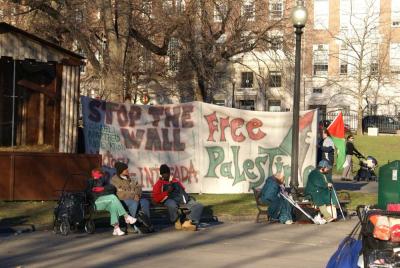
A scandal? A controversy? A University that is supposed to be a space of academic freedom and freedom of expression has shut the doors for an opinion that people who support this institution financially do not like? Yes, to some extent. But also more than that.
Brandeis University was founded by the American Jewish community in 1948, the same year that the state of Israel was counting its first days. It repeats that it is a non-sectarian institution. However… Although, most of the graduate students are not Jewish, a great number, if not the majority, of undergraduates either come from Israel or from the Jewish diaspora in the States. Moreover… Although the University is tolerant of any confessions at least in a sense that anyone can take time off during their religious celebrations, the general academic calendar is adjusted to the Jewish traditions, for example, instead of the Columbus day we have Yom Kippur as a no class day. But the issue is more complex than “the conservative Jewish community is the one to blame” and “The Boston Globe” has been right in pointing to the fractures that have been already proven to exist between the administration and the faculty on campus.
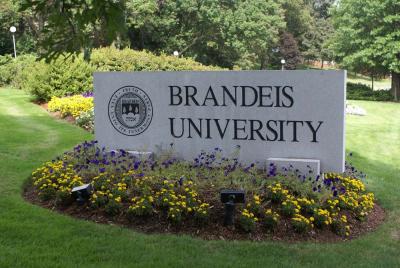
J. Reinharz, the voice and face of the University, at his inaugural address in 1995 said: "Brandeis has a clear and unambiguous identity that rests on four solid pillars: dedication to academic excellence, non sectarianism, a commitment to social action, and continuous sponsorship by the Jewish community." Leaving the issue of social justice and engagement aside as it will need more discussion some time, to many these goals might seem irreconcilable. But the fact of the matter is that Brandeis has been able to balance between academic freedom and financial allegiance to the Jewish diaspora quite successfully. Examples are abundant. Brandeis has a partnership with al-Quds University, which is an Arab institution. And Tony Kushner, who wrote the screenplay for the controversial Steven Spielberg's "Munich", received an honorary doctorate degree at Brandeis last May. Besides, Brandeis has one of the best programs in peace building in the country. However, there are examples of a rather different sort. Last May the exhibition of paintings by Palestinian children and teenagers was removed by a direct order of the president, who is believed to have been pressured by the sponsors. The exhibition went to M.I.T., Brandeis received negative coverage by “The Boston Globe” and the tension still exists between students, faculty members and the administration.
This tension has been enflamed again by the desired by some and unwished by others J. Carter's visit. Faculty members are still trying to convince him to come… they have been collecting donations for that, even though the former president said he would give a speech for free if the organizers could send a plane to take him from Georgia, which is a usual procedure for a figure of a status like his. Furthermore, one professor even suggested recommending the new book about Palestine for all the next year freshmen to read. The students, on their own right, have joined the faculty and the alumni in signing a petition calling for campus officials to bring J. Carter. After all the turmoil started and because of the attention it received from “The Boston Globe”, president J. Reinharz is now claiming that he would still like to see the former president and Nobel Peace Prize winner on campus. However, these are only the words of his spokesperson… And these are only the words so far. The show will go on and Brandeis will either take the open path of its ahead-looking faculty or turn the other way round and so declare challenging ideas and many promising students unwelcome.
Hopefully, to be continued…

A scandal? A controversy? A University that is supposed to be a space of academic freedom and freedom of expression has shut the doors for an opinion that people who support this institution financially do not like? Yes, to some extent. But also more than that.
Brandeis University was founded by the American Jewish community in 1948, the same year that the state of Israel was counting its first days. It repeats that it is a non-sectarian institution. However… Although, most of the graduate students are not Jewish, a great number, if not the majority, of undergraduates either come from Israel or from the Jewish diaspora in the States. Moreover… Although the University is tolerant of any confessions at least in a sense that anyone can take time off during their religious celebrations, the general academic calendar is adjusted to the Jewish traditions, for example, instead of the Columbus day we have Yom Kippur as a no class day. But the issue is more complex than “the conservative Jewish community is the one to blame” and “The Boston Globe” has been right in pointing to the fractures that have been already proven to exist between the administration and the faculty on campus.

J. Reinharz, the voice and face of the University, at his inaugural address in 1995 said: "Brandeis has a clear and unambiguous identity that rests on four solid pillars: dedication to academic excellence, non sectarianism, a commitment to social action, and continuous sponsorship by the Jewish community." Leaving the issue of social justice and engagement aside as it will need more discussion some time, to many these goals might seem irreconcilable. But the fact of the matter is that Brandeis has been able to balance between academic freedom and financial allegiance to the Jewish diaspora quite successfully. Examples are abundant. Brandeis has a partnership with al-Quds University, which is an Arab institution. And Tony Kushner, who wrote the screenplay for the controversial Steven Spielberg's "Munich", received an honorary doctorate degree at Brandeis last May. Besides, Brandeis has one of the best programs in peace building in the country. However, there are examples of a rather different sort. Last May the exhibition of paintings by Palestinian children and teenagers was removed by a direct order of the president, who is believed to have been pressured by the sponsors. The exhibition went to M.I.T., Brandeis received negative coverage by “The Boston Globe” and the tension still exists between students, faculty members and the administration.
This tension has been enflamed again by the desired by some and unwished by others J. Carter's visit. Faculty members are still trying to convince him to come… they have been collecting donations for that, even though the former president said he would give a speech for free if the organizers could send a plane to take him from Georgia, which is a usual procedure for a figure of a status like his. Furthermore, one professor even suggested recommending the new book about Palestine for all the next year freshmen to read. The students, on their own right, have joined the faculty and the alumni in signing a petition calling for campus officials to bring J. Carter. After all the turmoil started and because of the attention it received from “The Boston Globe”, president J. Reinharz is now claiming that he would still like to see the former president and Nobel Peace Prize winner on campus. However, these are only the words of his spokesperson… And these are only the words so far. The show will go on and Brandeis will either take the open path of its ahead-looking faculty or turn the other way round and so declare challenging ideas and many promising students unwelcome.
Hopefully, to be continued…
ieva jusionyte, 11:49h
... link (0 Kommentare) ... comment
Monday, 25. December 2006
mass at midnight
drums are calling tonight.
we are waiting...
observing the sacred ritual.
so many people gathered under the starry sky.
they hid in the house of their god.
they joined their hands.
African beat during the midnight Christmas Mass.
shadows of powers creeping in the edges of the dark.
they won't let go...
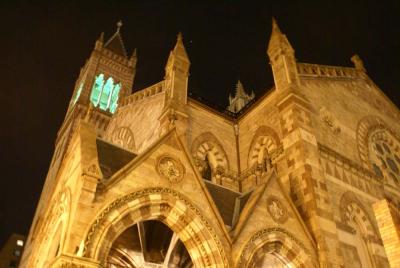
we are waiting...
observing the sacred ritual.
so many people gathered under the starry sky.
they hid in the house of their god.
they joined their hands.
African beat during the midnight Christmas Mass.
shadows of powers creeping in the edges of the dark.
they won't let go...

ieva jusionyte, 15:39h
... link (0 Kommentare) ... comment
Sunday, 24. December 2006
reflections on refugee art exhibition
To bring a cultural artifact to a memorial place it must first and foremost be classified as past, it must be situated in a specific niche of public memory, it should even be based on written history that kids can be taught at school. In this fashion not only brilliant inventions of mankind have been arranged in an evolutionary sequence behind the display glass, but also human suffering has been remembered only after it was recognized. For the survivors and descendants of such calamities as well as for the civic community museums have served as sanctuaries for the tragic bygone days. Memories of the Jewish Holocaust or the Armenian Genocide have been embodied in great number of monuments that show the world how evil it can be. However, although the peace accords were signed last year, the civil war in South Sudan cannot be labeled as past. It is a living history. Even though talks about opening a museum in Juba have started, the conflict is not over. It remains the menace for the present and many of the artists who created the paintings for the “Leave the Bones and Catch the Land” exhibition are still in Kakuma refugee camp. Nevertheless, Sudan People’s Liberation Army is in favor of opening the museum not only because, by establishing and legitimizing a story of South Sudan as different and autonomous, the fighting would have less ground, but also because the government expects the new Sudan to be built on the memories of the conflict. According to their point of view, civil war stigmatized southern Sudanese and the new state is to be centered on this bloody myth of origin.
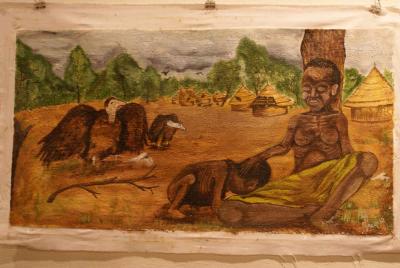
In the light of all this arranging an exhibition of refugee paintings has been a quest that required transcending the boundaries between politics and art. A child surrounded by vultures dying from hunger and protected only by the last strength of his mother in the work of Ajok Mayol or a huge dark-skinned refugee immersed in his fantasies about the white people while his leg is being cut in the painting of Stephenal Takiy are not only the colorful lines and shades on canvas that express the creativity and skillfulness of the artists. These pictures are a silent scream of the suffering. They constitute cultural heritage of a displaced people, they embody their living history. Therefore, the paintings could not be equated with traditional utensils of African tribes that museums have been so eager to collect and expose to the public, seeking exotic encounters. The paintings, whether portraying John Garang, Prophet Ngundeng or traditional courting and wedding are political not only due to the content but, most importantly, because the act of their creation itself was determined by decisions made in the realm of politics. And being such they are more than images on canvas; they demand response by action.
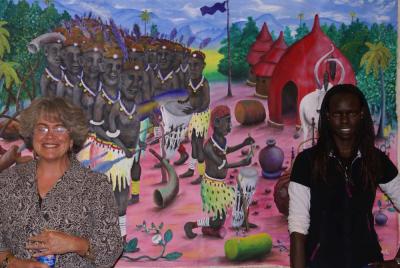
Since several years ago the folded canvases reached the U.S. without their authors, nobody but the collective curator, the class doing the project for Dr. M. Auslander’s course on “Museums and Public Memory”, was responsible for making sure that the message of those living in asylum in a refugee camp in northern Kenya is transmitted and understood. But in a situation like this the question had to be asked: how is resonance and wonder reconciled? How is the play between politics and poetics balanced? S. Greenblatt in his contribution to the volume of “Exhibiting Cultures: The Poetics and Politics of Museum Display” recognizes that by giving too much textual context resonance can kill wonder. Then what is the way the context of who, when, where and why of the displaced people could be combined with securing that the artistic character of the paintings remains intact? How is the compelling story of the refugees to be told without losing faith in the viewer who can interpret the work of art on his own? The struggle between educating people by actively raising their awareness of the invisible or unnoticed genocide in South Sudan and leaving art speak for itself expressed the tension of operating in between the domains of politics and art in the process of developing the exhibition.
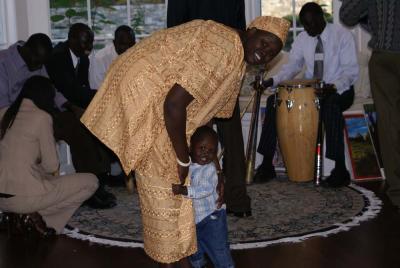
The class had to decide who the narrator of the story of the refugees from southern Sudan was to be. Authoritative voice of many traditional museums, which were once built in the spirit of Victorian anthropology, seemed to violate the subjectivities of the artists by imposing a static point of view which, because of the power of academic discourse, could claim to be objective. However, as G. Ch. Spivak observes in a groundbreaking essay “Can the Subaltern Speak?”, overcoming this epistemic violence by granting the “voice” to the subalterns in postcolonial discourse, trying to re-establish their collective locus of agency, is also a slippery road that could re-inscribe neo-colonial imperatives on the people whose story is being told. Firstly, it is dangerous because it is only through intellectuals, even if these are students, that the subalterns are allowed to speak. Secondly, such an attempt is based on an assumption of cultural solidarity among the heterogeneous people. The solution was to include multiple voices that, instead of hiding the narrator behind the veil of supposedly objective academic language, can show the complex development of the exhibition as a process. The captions that accompany the paintings in the exhibition as well as the audio tour combine the knowledge students gathered about the Dinka culture and history of civil war with the quotes from interviews with members of the southern Sudanese diaspora community in the U.S. As voices of the students and those of the refugees are polyphonic in the exhibition, the tension between resonance and wonder is diminished.
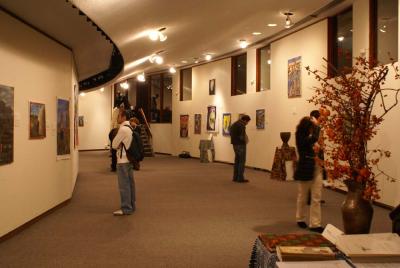
The project of installing this exhibition manifested the advantages of community engaged learning. Not only did students have an opportunity to learn from the experiences of southern Sudanese, the so-called lost boys and girls of Sudan (who have grown up and this title that attracts attention will have to be changed), spending long afternoons talking about cattle as bride-wealth, dangers awaiting upon entering one’s memories or education and food rationing in Kakuma refugee camp, but they could also contribute to the cause. Cooperation with the community partners, such as Sudanese Education Fund, African Refugee Artists Club and South Sudan Youth Association of Massachusetts, proved that socially aware public anthropology can be of use for the diaspora. Activist research, as opposed to colonial anthropology that served the interests of imperialist administration, which often found itself incapable of managing its newly conquered “savage” subjects, exchanges knowledge for assistance.
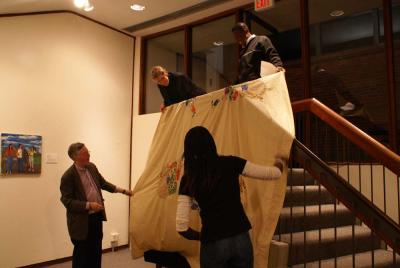
Definitely it is art, either in the form of the paintings from Kakuma, jazz collaborations, books of memoirs (“They Poured Fire on Us from the Sky”) or popular documentary movies (“God Grew Tired of Us”), that enabled the creation of the solid ground for cooperation. Art is the open meeting space for all of those who are eager to learn and to engage in conversations. And it is art that will continue the quest of making the collective memories of southern Sudanese public. In their statement of mission the group of African artists taught by Atem Aleu in Kakuma declares that “art connects us to each other through space and time, and lends morale support to those of us still living the lives we express in our paintings”. “Leave the Bones and Catch the Land” is not a fixed museum exhibition. It is mobile and its task is to travel around broadening the ranks of the aware. Discussions of repatriation and cultural property rights in regard to the paintings have not started yet and, probably, they should not start at all. Refugee art belongs to a displaced and stigmatized community, therefore, also to the whole world whose ignorance contributed to their suffering. It has more effect when being abroad than when returning home because Juba is not where the paintings were made. They do not have home. They are nomadic. Just like the people who created them.
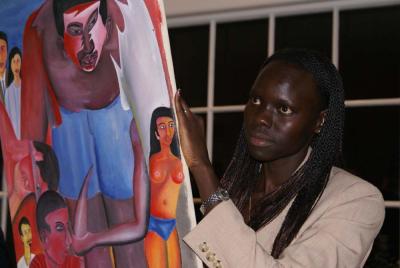
An aftermath is a word which doesn’t exist in a project like this. With the opening of the Southern Sudan Cultural Documentation Center at Brandeis the work continues. The war in Sudan can be enflamed any time by the ignorance of the international community to such incidences as happened in Malakal in early December. However, although the goal of showing the story of the refugees through their paintings is of political nature, the quest can only be successful because it is art that speaks for the trauma, transcending the officially recognized boundaries between the realms of power and creativity. Serving both - the dispersed southern Sudanese and the civil society across the continents - the paintings from Kakuma unite memorial and educational objectives. They testify that the story of the refugees is not in the past yet and the struggle to include it into the public memory of the world is still under way.
To see the paintings and more, visit http://www.brandeis.edu/projects/sudan_center/kakuma_exhibit/

In the light of all this arranging an exhibition of refugee paintings has been a quest that required transcending the boundaries between politics and art. A child surrounded by vultures dying from hunger and protected only by the last strength of his mother in the work of Ajok Mayol or a huge dark-skinned refugee immersed in his fantasies about the white people while his leg is being cut in the painting of Stephenal Takiy are not only the colorful lines and shades on canvas that express the creativity and skillfulness of the artists. These pictures are a silent scream of the suffering. They constitute cultural heritage of a displaced people, they embody their living history. Therefore, the paintings could not be equated with traditional utensils of African tribes that museums have been so eager to collect and expose to the public, seeking exotic encounters. The paintings, whether portraying John Garang, Prophet Ngundeng or traditional courting and wedding are political not only due to the content but, most importantly, because the act of their creation itself was determined by decisions made in the realm of politics. And being such they are more than images on canvas; they demand response by action.

Since several years ago the folded canvases reached the U.S. without their authors, nobody but the collective curator, the class doing the project for Dr. M. Auslander’s course on “Museums and Public Memory”, was responsible for making sure that the message of those living in asylum in a refugee camp in northern Kenya is transmitted and understood. But in a situation like this the question had to be asked: how is resonance and wonder reconciled? How is the play between politics and poetics balanced? S. Greenblatt in his contribution to the volume of “Exhibiting Cultures: The Poetics and Politics of Museum Display” recognizes that by giving too much textual context resonance can kill wonder. Then what is the way the context of who, when, where and why of the displaced people could be combined with securing that the artistic character of the paintings remains intact? How is the compelling story of the refugees to be told without losing faith in the viewer who can interpret the work of art on his own? The struggle between educating people by actively raising their awareness of the invisible or unnoticed genocide in South Sudan and leaving art speak for itself expressed the tension of operating in between the domains of politics and art in the process of developing the exhibition.

The class had to decide who the narrator of the story of the refugees from southern Sudan was to be. Authoritative voice of many traditional museums, which were once built in the spirit of Victorian anthropology, seemed to violate the subjectivities of the artists by imposing a static point of view which, because of the power of academic discourse, could claim to be objective. However, as G. Ch. Spivak observes in a groundbreaking essay “Can the Subaltern Speak?”, overcoming this epistemic violence by granting the “voice” to the subalterns in postcolonial discourse, trying to re-establish their collective locus of agency, is also a slippery road that could re-inscribe neo-colonial imperatives on the people whose story is being told. Firstly, it is dangerous because it is only through intellectuals, even if these are students, that the subalterns are allowed to speak. Secondly, such an attempt is based on an assumption of cultural solidarity among the heterogeneous people. The solution was to include multiple voices that, instead of hiding the narrator behind the veil of supposedly objective academic language, can show the complex development of the exhibition as a process. The captions that accompany the paintings in the exhibition as well as the audio tour combine the knowledge students gathered about the Dinka culture and history of civil war with the quotes from interviews with members of the southern Sudanese diaspora community in the U.S. As voices of the students and those of the refugees are polyphonic in the exhibition, the tension between resonance and wonder is diminished.

The project of installing this exhibition manifested the advantages of community engaged learning. Not only did students have an opportunity to learn from the experiences of southern Sudanese, the so-called lost boys and girls of Sudan (who have grown up and this title that attracts attention will have to be changed), spending long afternoons talking about cattle as bride-wealth, dangers awaiting upon entering one’s memories or education and food rationing in Kakuma refugee camp, but they could also contribute to the cause. Cooperation with the community partners, such as Sudanese Education Fund, African Refugee Artists Club and South Sudan Youth Association of Massachusetts, proved that socially aware public anthropology can be of use for the diaspora. Activist research, as opposed to colonial anthropology that served the interests of imperialist administration, which often found itself incapable of managing its newly conquered “savage” subjects, exchanges knowledge for assistance.

Definitely it is art, either in the form of the paintings from Kakuma, jazz collaborations, books of memoirs (“They Poured Fire on Us from the Sky”) or popular documentary movies (“God Grew Tired of Us”), that enabled the creation of the solid ground for cooperation. Art is the open meeting space for all of those who are eager to learn and to engage in conversations. And it is art that will continue the quest of making the collective memories of southern Sudanese public. In their statement of mission the group of African artists taught by Atem Aleu in Kakuma declares that “art connects us to each other through space and time, and lends morale support to those of us still living the lives we express in our paintings”. “Leave the Bones and Catch the Land” is not a fixed museum exhibition. It is mobile and its task is to travel around broadening the ranks of the aware. Discussions of repatriation and cultural property rights in regard to the paintings have not started yet and, probably, they should not start at all. Refugee art belongs to a displaced and stigmatized community, therefore, also to the whole world whose ignorance contributed to their suffering. It has more effect when being abroad than when returning home because Juba is not where the paintings were made. They do not have home. They are nomadic. Just like the people who created them.

An aftermath is a word which doesn’t exist in a project like this. With the opening of the Southern Sudan Cultural Documentation Center at Brandeis the work continues. The war in Sudan can be enflamed any time by the ignorance of the international community to such incidences as happened in Malakal in early December. However, although the goal of showing the story of the refugees through their paintings is of political nature, the quest can only be successful because it is art that speaks for the trauma, transcending the officially recognized boundaries between the realms of power and creativity. Serving both - the dispersed southern Sudanese and the civil society across the continents - the paintings from Kakuma unite memorial and educational objectives. They testify that the story of the refugees is not in the past yet and the struggle to include it into the public memory of the world is still under way.
To see the paintings and more, visit http://www.brandeis.edu/projects/sudan_center/kakuma_exhibit/
ieva jusionyte, 11:43h
... link (0 Kommentare) ... comment
Saturday, 23. December 2006
behind the scenes

Why did I decide to open a blog? The easiest answer is that yesterday during lunch with two of my professors from Brandeis they asked me why I don't have one. Actually, there is little need to look for reasons behind that... Journalism is still in my blood and I can't renounce it. So is civil activism, which has started to complicate my understanding of anthropology. Until now I was a youth activist and my work as a news correspondent only contributed to that mission and responsibility for the people I felt. Anthropology was a discipline that allowed unexpected insights into the processes surrounding me, therefore, it was fun. It was a sophisticated, almost magical Glasperlenspiel. I could reflect on my activism - organizing protests in front of foreign embassies, campaigning for the reform of higher education in Lithuania, transgressing the boundaries between a reporter and a participant in the revolutionary Minsk - using anthropological concepts and theories, however, it was never the other way round. But in September with Mark Auslander's class we started working for the development of a refugee art exhibition. And a month or so ago for Elizabeth Ferry's class "Power and Violence" I had to read two books - Samantha Power's "A Problem from Hell: America and the Age of Genocide" and Paul Farmer's "AIDS and Accusation: Haiti and the Geography of Blame". The first one tells the story of Washington's permanent inaction in the face of all the genocides of the twentieth century and the second is about structural violence affecting the survival of sick people in rural Haiti. Therefore, although being lost due to the detachment from all my previous activist engagement in Lithuania, I rediscovered it again here. From a different end, though. Now I am willing to ask whether there can be other than activist anthropology? Is there an alternative to socially aware and publicly engaged research? Can an anthropologist continue observing his subjects when they, one after the other, disappear from his field? How to behave in such an encounter? And is it possible to remain an observer for the sake of objectivity in life-threatening situations? Can anthropologists do fieldwork anywhere else than in dangerous, war-ridden places? What is the meaning of analysing the food culture in France other than just intellectual satisfaction of applying old or developing new abstract theories? How can anthropology be something other than politically engaged? Although I have some experience that makes these questions relevant, I still lack encounters... Therefore, I won't try to answer them right away. They are too complex, maybe too immature still. But I hope to use this space as my diary open to others whose critique is more than welcome (either directly here or at my e-mail address ieva@brandeis.edu). I hope it will help settle my thoughts down. And much more than that... much more than anthropology. I often find myself willing to comment on life in the U.S. or at Brandeis as an interesting academic institution in particular, but lacking a semi-public space to do that. Just record some notes on the margins of big politics, international relations, minor cultural issues, controversies... everything that might be interesting and can get lost in the daily flow of information, if unreflected, if let go...
ieva jusionyte, 22:37h
... link (0 Kommentare) ... comment